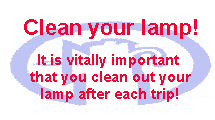

The key to keeping a lamp functioning over a long period of time is careful attention to maintenance and cleaning. As has already been mentioned, the calcium hydroxide produced from using calcium carbide is harmful. This extends to the inside of your lamp. Within 12 hours of your caving trip, you will need to clean out your lamp. Failure to do so will cause a lamp to have corrosion, clogs, frozen bottoms, and a myriad of other problems.
Carefully chose a location for cleaning out the lamp. You could take it to your bathroom sink. However, then you will be washing out the lime into the same area that you brush your teeth! Not to mention the fact that the lime will (over time) corrode the pipes. It is probably best to use an expendable bucket and take your lamp outside. Where dumping a pile of spent carbide will more than likely have an ecological impact on wildlife, the small, diluted amounts left from cleaning out a lamp is minimal.
The best way to ensure that your lamp is clean is to disassemble it. Using an old toothbrush, scrub the threads, valve stem, and brass components of the felt assembly. It may also be helpful to rub off any lime from the gasket. Make sure that you clean the tip with a tip cleaner and/or by running water though it. Furthermore, refill the top with water and turn the valve on about half way. This will flush the drip mechanism.
This would also be a good time to check your gasket for cracks or other signs of age. It may help you prevent a nasty surprise later.
Should the reflector have become dirty on the trip, it will also need to be cleaned. Water is usually sufficient to remove mud or carbon deposits. If it seems necessary you may wish to use toothpaste on the reflector as a cleaning agent. Toothpaste is the harshest abrasive you should use. Should you scratch the reflector you will reduce your light output underground.
Following these guidelines will ensure that your lamp continues to run smoothly.
Click here if this page appears outside of its frames.